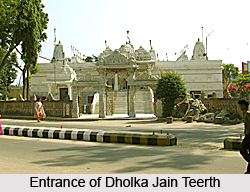 Dholka Jain Teerth is a Jain pilgrimage centre. Dholka is a city located in Ahmedabad District of the Indian state of Gujarat. The principal deity of the temple is Lord Kalikund Parshvanatha. According to history the name of this city was Dhavalakkapur. During the times of the Mahabharata, this was a vast city. It is also regarded as the birth place of His Holiness Dadashri Jinadattasurishvarji and the holy land of initiation (diksha) of Upadhyay Dharmadevji. During the twelfth century of the Vikram Samvat Era many temples were built here. It also remained associated with many religious activities. Under the inspiration of His Holiness Acharyadev Vijayrajendrasurisvarji auspices of Kanaksurisvarji, the idol of Lord Kalikund Parshvanatha was installed in the temple.
Dholka Jain Teerth is a Jain pilgrimage centre. Dholka is a city located in Ahmedabad District of the Indian state of Gujarat. The principal deity of the temple is Lord Kalikund Parshvanatha. According to history the name of this city was Dhavalakkapur. During the times of the Mahabharata, this was a vast city. It is also regarded as the birth place of His Holiness Dadashri Jinadattasurishvarji and the holy land of initiation (diksha) of Upadhyay Dharmadevji. During the twelfth century of the Vikram Samvat Era many temples were built here. It also remained associated with many religious activities. Under the inspiration of His Holiness Acharyadev Vijayrajendrasurisvarji auspices of Kanaksurisvarji, the idol of Lord Kalikund Parshvanatha was installed in the temple.
Temple of Dholka Jain Teerth
The temple of Dholka is dedicated to Lord Parshvanatha. The idol is about 120 cms in height and is white in colour. The idol is seated in a Padmasana posture. It is a 2200 years old idol and has been installed in this vast, high multi-stepped temple on the third day of the bright half of the month of Fagum in the year 2038 of the Vikram Samvat Era. Dadavadi of Shri Jinadattasurishvarji, the great Acharya of Khartargachchha, is located in front of this temple. Near the main temple, a Mini-Shetrunjaya temple can also be seen. It seems like a 45 ft high artificial hill. The city of temples is built on the land of 25000 square ft. The mini-shetrunjaya is adorned with `Jal Taleti`, `Babuna Dera` temple of Bhagawan Shantinath`, `Dada`s Tank`, `Nava tunk`, `Getina Paga.` All these give a gorgeous look to mini-shetrunjaya. Apart from these there are two other temples also located at this place. Devotees can also see many other beautiful idols here. The present Mini-Shetrunjaya is modelled like the very beautiful and valuable sacred place of Shetrunjaya. The pilgrim place is visited by pilgrims from far off places. The scenic beauty of the site also mesmerizes the devotees.
Devotees can reach Dholka Jain Teerth via road. The nearest railway station of Dholka is at a distance of one kilometre. Bus service and vehicle-service are easily available at this sacred place on the Vadodara Palitana road.




















